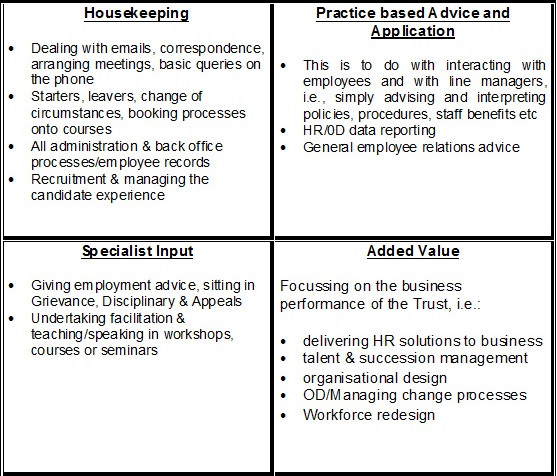HR Tendering and Outsourcing
There are areas of HR that have little or no evidence of being outsourced successfully. Analysis suggests that these are HR services such as:
- - HR policy and strategic development
- - HR business partnering
- - recruitment authority and selection decisions.
- - employee relations and collective bargaining.
- - strategic training needs and talent management
- - exit/severance decisions
Tendering and outsourcing promises cost savings and service improvement but what are the realities. We need to split between transaction costs and people-to-people interactions.
In the NHS ‘collaborations’ should not be confused with ‘shared services’ outsourcing. Would your Trust want to share its value chain probably not but what is feasible and what is desirable in outsourcing?
There are two sources of HR work:
- 1. Reactive and Transactional
- - Advice to managers and staff on basic Trust policy matters
- - All administration and back office processes
- - Staff records
- - Recruitment and selection of candidates
- - Managing the candidate experience
- - Employee relations advice
- - Temporary staffing arrangements
- - Managing ER Projects
- - Staff Benefits provision
- - HR Data reporting
-
2. Transforming Business Performance
- - HR & Workforce planning
- - Delivery of solutions into the business
- - Talent & succession management
- - Organisation design
- - Managing change Programmes
- - Managing the business relationship
Which leads us neatly to what HR do in an average week:
WHAT HR & ORGANISATION DEVELOPMENT DOES IN AN AVERAGE WEEK
(Business Development Categories)

It may seem obvious but logical considerations are often ignored in this area. There are multiple drivers behind outsourcing. It is partly a management fad (where are other fashions like ‘empowerment’ and ‘stakeholders’ now?), partly a response to the temptation of ‘reducing costs’, partly an ideological belief that ‘private’ is better than ‘public’, and partly a response to failings in the public service delivery. It is this last element that Strategic HR Solutions get involved.
The drivers in a modern organisation remain:
- 1. Cost
- - by cutting staff numbers
- - by greater efficiency in what was done and have it was done
- 2. Quality
- - being more client or patient driven
- - being more accessible – contact and hours of work
- - improving supply of inferstruction
- 3. Organisational Reasons
- - achieving structural flexibility
- - better organisational learning
- - repositioning HR
- 3. Organisational Reasons